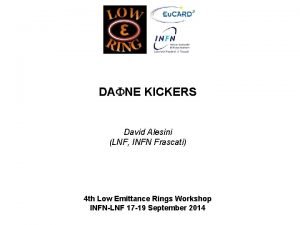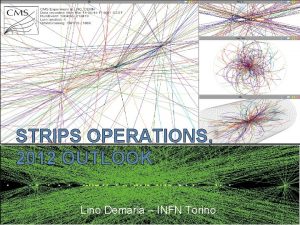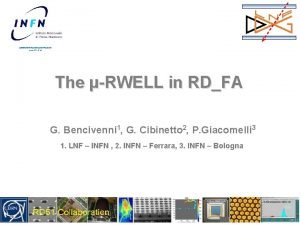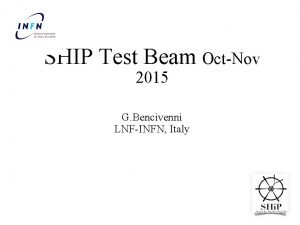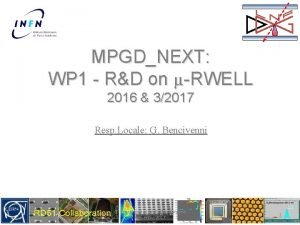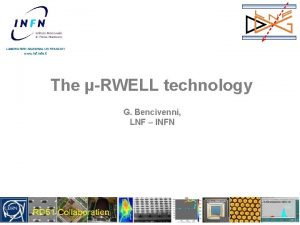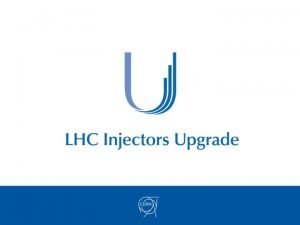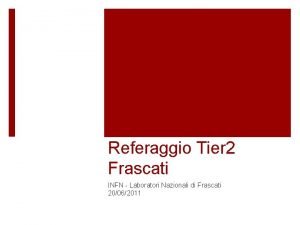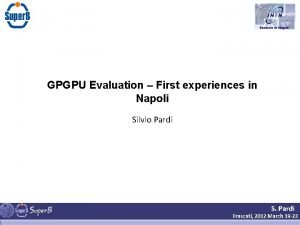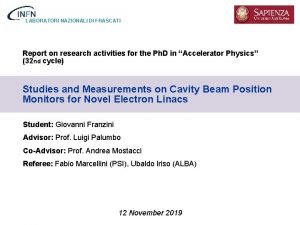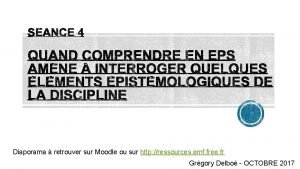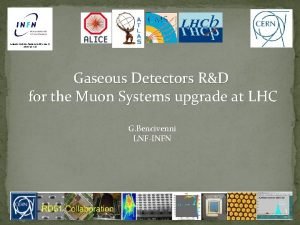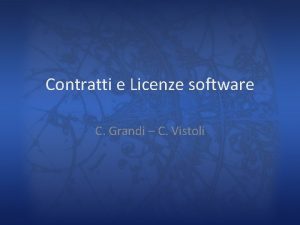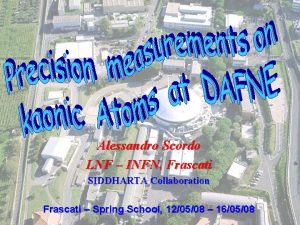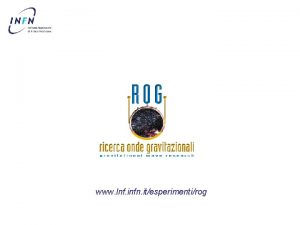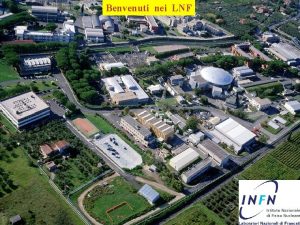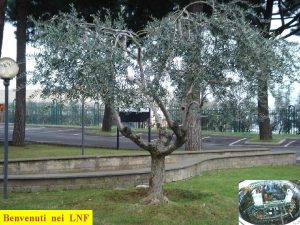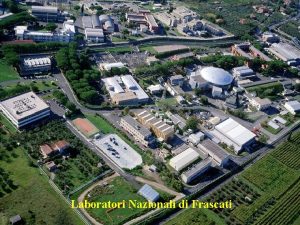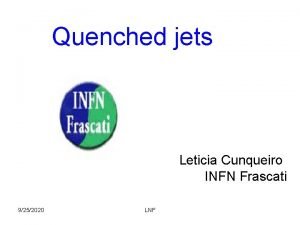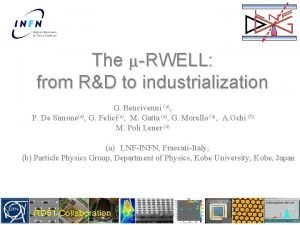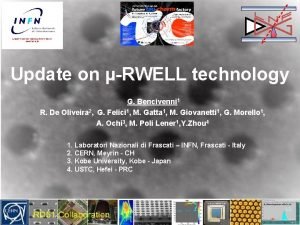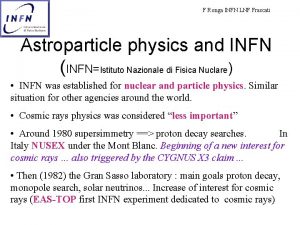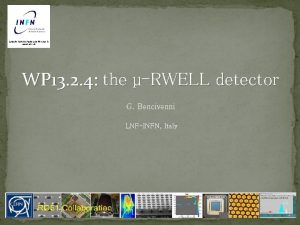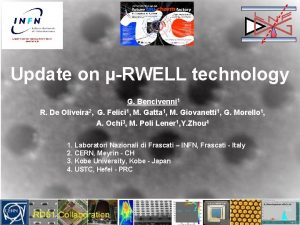DA NE KICKERS David Alesini LNF INFN Frascati






![NEW KICKERS: PARAMETERS Beam Energy E [Me. V] 510 Time spacing between bunches [ns] NEW KICKERS: PARAMETERS Beam Energy E [Me. V] 510 Time spacing between bunches [ns]](https://slidetodoc.com/presentation_image/76a7d0219b0e973c0127ead31b670496/image-7.jpg)














- Slides: 21

DA NE KICKERS David Alesini (LNF, INFN Frascati) 4 th Low Emittance Rings Workshop INFN-LNF 17 -19 September 2014

OUTLINE DA NE injection kickers design criteria measurements installation and test DR-ILC kickers studies tapered strip advantages on beam coupling and transfer impedance effects of the non-uniformity of deflecting field DA NE horizontal feedback kickers design criteria Installation and test

DA NE INJECTION SYSTEM The bunches coming from the damping ring are injected into each ring through the injection kickers 1. The second kicker just compensates the oscillations in the stored bunches caused by the injection kick. Old injection kickers were realized with two coils. The length of the kicking pulse were approximately 150 ns. The new kickers have been realized to operate with new fast pulse generators. Compared to the previous devices, the new system has the following main features: -possibility to implement injection with much shorter pulse (12 ns instead of 150 ns); -better uniformity of the deflecting field as a function of the transverse coordinates; -lower beam coupling impedance -possibility of higher repetition rate (50 Hz). DA NE parameters (SIDDHARTA runs 2008 -2009) Energy E [Me. V] Max. beam current IM [A] # of colliding bunches 510 2. 2 (e-) 1. 1 (e+) 110 RF frequency f. RF [MHz] 368. 67 RF voltage [k. V] 150 -170 Harmonic number 120 Bunch spacing TB[ns] 2. 7 (=1/f. RF) Max Luminosity L [cm-2 s-1] 4. 5 1032

THE NEW DA NE INJECTION KICKER [D. Alesini et al. , PRST, 13, 111002 (2010)] The kicker is basically a two stripline structure, where both the striplines and the surrounding chamber have been tapered. Each transverse section has constant 50 Ω impedance to match the output impedance of the high voltage pulse generator. The deflecting field flatness has been obtained with a proper choice of the ratio between the length of tapered and straight sections while the beam impedance reduction is the result of the tapering. The novelty of the new DA NE kickers with respect to previous devices is the introduction of the tapered striplines to simultaneously obtain: -low beam coupling and transfer impedances -excellent uniformity of the deflecting field -better matching between the strip and the pulse generators PARAMETER DA NE ILC Total deflecting voltage VT [MV] 2. 5 3. 8 Total deflection angle [mrad] 5 0. 76 Rise time of the kicker pulse [ns] <6 <6 Decay time of the kicker pulse [ns] <6 <6 Flat top kicker pulse [ns] >0. 5 > 0. 12 >50 >52 Horizontal beam stay clear @ kicker Input ports Strip ceramic supports Tapered stripline [mm] (diameter) Bunch length of injected bunches [mm] 35 6 Relative amplitude jitter <5% <0. 065% Maximum Rep. rate [Hz] 50 3. 106 Number of injected bunches 120 2625 Elliptical cross section HV feedthrough BEAM Output ports (LOAD)

ELLIPTICAL CROSS SECTION OF THE STRIPLINES: EFFICIENCY AND UNIFORMITY OF THE DEFLECTING FIELD The TEM deflecting mode can be excited by feeding the two strips with opposite voltages while, to have a net deflection, the particle beam has to travel in the opposite direction with respect to the TEM wave. For a given stripline aperture it is possible to calculate the total equivalent deflecting field ET at the center of the structure, normalized to the input voltage per strip VP, as a function of the coverage angle. The intensity of the deflecting field increases if increases but, on the other hand, also the distance between the strip and the vacuum chamber itself has to be increased to maintain the strip impedance constant For large coverage angles, the efficiency of an elliptical stripline is larger than the circular one because the strip is closer to the center of the pipe. a=25 mm Another important point to be taken into account is the behavior of the deflecting field as a function of the transverse coordinates (x-horizontal, y-vertical).

DESIGN CRITERIA OF THE NEW KICKERS The design of the kickers is based on the idea to properly taper the striplines and the surrounding vacuum chamber. Each transverse section should have constant impedance in order to avoid reflections of the input pulse. The tapered scheme allows to: a) b) c) d) reduce the broadband beam coupling impedance since the discontinuity of the striplines is mitigated by the introduction of the tapers; improve the deflecting field quality obtaining a uniform transverse deflection as a function of the transverse coordinate (horizontal in particular); obtain a better matching between the generator and the kicker structure at high frequency avoiding multiple reflections of the deflecting pulse; reduce the beam transfer impedance. (a) Integrated deflecting field as a function of the horizontal and vertical (b) coordinates; (c) deflecting field in the center of the structure as a function of the longitudinal coordinate
![NEW KICKERS PARAMETERS Beam Energy E Me V 510 Time spacing between bunches ns NEW KICKERS: PARAMETERS Beam Energy E [Me. V] 510 Time spacing between bunches [ns]](https://slidetodoc.com/presentation_image/76a7d0219b0e973c0127ead31b670496/image-7.jpg)
NEW KICKERS: PARAMETERS Beam Energy E [Me. V] 510 Time spacing between bunches [ns] 2. 7 Deflection [mrad] 5 Total deflecting voltage VT [MV] 2. 5 Total kicker length L [cm] 90 Voltage per strip [k. V] 45 Input pulse length [ns] 5 Pulse length “seen” by bunches [ns] 10 Max rep rate [Hz] 10 The whole kicker dimensions included the length of the tapers have been designed to have an integrated deflecting voltage along the kicker of 2. 5 MV with a maximum input voltage per strip of 45 k. V. The typical high voltage input pulse signal is given in the figure. The pulse has a very short rise time (of about 300 ps), a longer decay time (of about 2. 5 ns) with a flat top time of about 5 ns. From this profile it is possible to calculate the total deflecting field as a function of the bunch time arrival in the kicker structure. The result is shown in the figure.

RF MEASUREMENT RESULTS: REFLECTION COEFFICIENT The final mechanical drawing (crosssection) of the kickers and a picture of the realized kicker are shown in the figure. The strip is sustained by ceramic supports. Since commercial 50 high voltage feedthroughs do not exists, they have been developed at LNF. Reflection coefficient at the input port: HFSS simulations and measurements.

RF MEASUREMENT RESULTS: BEAM COUPLING IMPEDANCES The wire method technique has been used to fully characterize the kicker beam coupling and transfer impedances. The longitudinal coupling impedance has been measured with several different terminations at the 4 kicker ports: when 50 Ω matches each port; when the two input ports are closed on short circuits and the output ports are on 50 Ω, and when the 50 Ω are replaced by the real HV 50 Ω load built to be used for the operation. The first of these measurements give the impedance of the stand-alone kicker, while the other two take account of mismatches introduced by connecting the pulsers (a short circuit is used to simulate the pulser in the worst possible condition). Perfect matching of the 4 ports The transfer impedance allows the evaluation of the peak voltage and the average power induced by the beam into the kicker ports for a given beam current. The maximum induced peak voltage on the upstream (output) ports is <100 V with a 6 n. C bunch charge while the average power induced on the ports is <10 W with a 2 A beam.

DA NE OPERATION WITH THE NEW KICKERS (1/3) Four new kickers have been installed since November 2007. They always worked properly and the only problem we had was related to a wrong brazing of few mini-bellows. The damaged mini-bellows have been replaced. The injection with the high voltage fast pulse generators has been successfully tested. The figure shows the r. m. s. oscillation amplitude of 100 stored bunches with the kicker pulse centered on bunch 50 obtained with the horizontal digital feedback diagnostics. As expected the bunches 49 and 51 takes approximately half the kick maximum amplitude, while bunches 48 and 52 are only very little perturbed. As a matter of fact, the operation with fast pulse generators has shown a poor reliability, even after repair and substitution of damaged parts with upgraded ones. The reasons of such poor reliability have not been understood. In any case we never had the possibility to use routinely and at the same time the eight fast pulsers.

DA NE OPERATION WITH THE NEW KICKERS (2/3) Several different injection configurations have been therefore used. For great part of the operation time, the kickers worked with the old long pulse generators in both the rings. In this configuration the two strips are connected in series and the kick is only given by the magnetic field one. (MAX STORED CURRENT e- >2. 5 A) PARAMETERS Deflection/current [mrad/k. A] 2. 7 Total deflecting voltage VT/current [MV/k. A] 1. 38 Also a different “hybrid” configuration has been successfully tested. In this case the two kinds of pulsers (long and fast) were used together on the same kicker, connecting each one to a different stripline. Figure shows, as example, the sum of the signal detected at the two stripline outputs ports of each kicker in this configuration.

DA NE OPERATION WITH THE NEW KICKERS (3/3) The new stripline kicker has been also used as an additional kicker for the horizontal feedback in the positron ring. One stripline of both the kickers of the DANE positron ring have been connected with the old-long pulser for beam injection and the remaining stripline connected to the amplifiers of the feedback system. Thanks to this configuration it has been possible to increase the stored current in the e+ ring to more than 1 A. With the aim to overcome the problems related to the fast pulser reliability, it has been decided to try a different and more compact model that produces an output pulse having the same shape but a reduced amplitude from 45 k. V to 25 k. V. In spite of the lower kick voltage, increasing ß function in the kicker region and changing the beam orbit in the septa, the injection was possible as well. According to the hybrid scheme, two 25 k. V units were installed in the electron ring at the end of the SIDDARTHA run (September 2009 -November 2009) and have been successfully tested up to the end of the run for about two months of operation without problems. The injection kickers (not the “compensating” ones) have been also modified with a “cut and paste” operation and now the strip distance in the center of the kicker is 40. 8 mm instead of 54. 8 mm. This increases the kicker efficiency by 40%.

GENERAL CONSIDERATIONS: ADVANTAGES OF TAPERED KICKERS ON BEAM IMPEDANCE The advantages in tapering the striplines of the kickers can be pointed out with simple electromagnetic simulations. We consider, as an example, the case of a kickers with the dimensions reported in figures. The two kickers give the same deflecting field for a given strip voltage and have the same electrical length. The longitudinal beam coupling impedance and the transfer impedance calculated by Gdfid. L in the two cases up to 20 GHz are reported in figures. The results show the strong reduction of the impedance and transfer impedance content when we have a tapered geometry. From HFSS simulation it is also easy to verify that the reflection coefficient at the input port is also reduced above 1 GHz.

GENERAL CONS. : UNIFORMITY OF THE DEFL. FIELD (1/4) PARAMETERS (ILC) x_KICK=65 m; y_KICK=20 m Ax_max=Ay_max=0. 09 m rad (injected) Bunches distance = 3. 08 ns stripline geometries Geometry 1 y /2=45 deg 25 mm Geometry 2 x

GENERAL CONS. : UNIFORMITY OF THE DEFL. FIELD (2/4) Geometry 1 Geometry 2

GENERAL CONS. : UNIFORMITY OF THE DEFL. FIELD (3/4) Horizontal plane Geometry 1 Ax_max=0. 15 m rad Vertical plane Ay_max=0. 13 m rad Ax_98%=0. 11 m rad Ay_98%=0. 09 m rad

GENERAL CONS. : UNIFORMITY OF THE DEFL. FIELD (4/4) Geometry 1 Vstrip=10 k. V

OTHER APPLICATIONS: NEW TAPERED KICKER FOR THE DA NE TRANSVERSE FEEDBACK The new horizontal DA NE kickers of the horizhontal feedback system have been designed using the same “phylosophy” of tapered striplines. 20 cm striplines 22 cm+ 2*12 cm tapers

PERFORMANCES OF THE NEW TRANSVERSE FEEDBACK KICKERS Transverse shunt impedance In the horizontal plane we incresed the perrformances of the feedback system by a factor 5 with respect to the “old” system Courtesy A. Drago

CONCLUSIONS -The design of the new DA NE injection kickers has been based on elliptical and tapered striplines with HV 50 Ohm feedthroughs. Using a tapered stripline it has been possible to simultaneously reduce the impedance of the device and to improve the deflecting field quality. -They have been successfully installed in the collider demonstrating to be very versatile devices to be used in different operation conditions. -Injection with the 45 KV pulsers has been successfully tested but showed poor reliability -Other possible injections scheme have been tested successfully: with the old long pulse generators and in a hybrid configuration -Lower voltage (25 k. V) fast pulse generators have been successfully tested for two months and they will be finally used for injection in the next DA NE run -Low power RF measurements have been also done and compared with simulations showing a very good agreement and a total comprehension of the device from the electromagnetic point of view -General advantages of tapered kickers and critical issues on the uniformity of the deflecting field have been also pointed out. -A similar approach has been also successfully adopted for the kickers of the horizontal feedback system

THANKS TO… P. Raimondi, F. Marcellini, G. Sensolini, A. Drago, C. Milardi, M. Zobov, S. Pella, M. Serio, A. Ghigo, S. Guiducci, A. Zolla and… the DA NE team!
 David alesini
David alesini David alesini
David alesini Infn torino webmail
Infn torino webmail Www.lnf.infn.it
Www.lnf.infn.it Lnf.infn.it
Lnf.infn.it Www.lnf.infn.it
Www.lnf.infn.it Lnf.infn.it
Lnf.infn.it Worb fussballplatz
Worb fussballplatz Eric montesinos
Eric montesinos Doc phone frascati
Doc phone frascati Silvio frascati
Silvio frascati Bpm frascati
Bpm frascati Lnf mensa
Lnf mensa Moodle espe lnf
Moodle espe lnf Www.lnf
Www.lnf Lnf online
Lnf online Lnf foundation phase
Lnf foundation phase Literacy and numeracy framework
Literacy and numeracy framework Licenze nazionali infn
Licenze nazionali infn Godiva infn
Godiva infn Infn lnl
Infn lnl Maria grazia pia
Maria grazia pia
